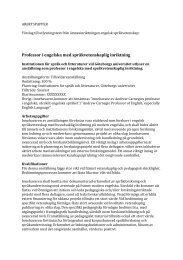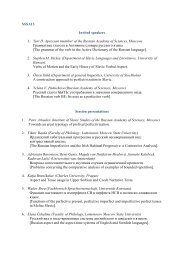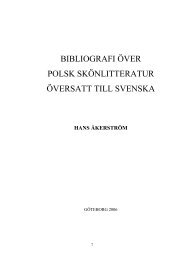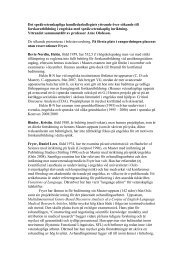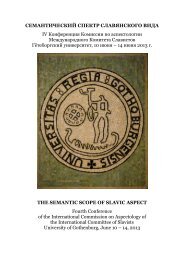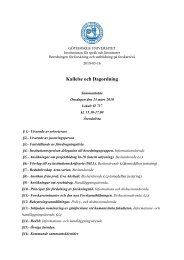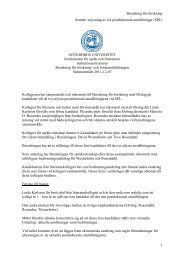whom have devoted many years to serious traditional study of the instrument under Japanesemasters. Detailed information regarding their work with the ensemble is available on the primaryonline resource for international shakuhachi players, “shakuhachi.com.” According to thatresource, Mnatsakanov studied shakuhachi under Ronnie Nyogetsu Seldin, Koku Nishimura,Ikkei Nobuhisa Hanada, and Kohei Simidzu. 35 According to the ensemble’s own website, Mnatsakanovfirst studied under the guidance of Om Prakash, in Germany, pursued additional studieswith Michiaki Okada, Reisho Yonemura, and Kifu Mitsuhashi, and in 1998 first began playingJapanese traditional music with the Wa-On Ensemble at the Tchaikovsky Conservatory. 36 DmitryKalinin, the other leader of the Pan-Asian Ensemble, was born in 1975 in Moscow. He has studiedshakuhachi (kinko-ryu) and koto (ikuta-ryu) extensively with various teachers in both Kyotoand Moscow. In 2004 he even attained certification as a koto teacher through the Sawai Tadaokoto school. He is a graduate of the composition department of the Tchaikovsky Conservatory,where he studied under professors K. K. Batashev and A. B. Bobylev. According to the Pan-AsianEnsemble’s website, he was “a soloist and an artistic director of Japanese music ensemble at P.I.Tsaikovsky Moscow State Conservatory “Wa-on”. Kalinin and Mnatsakanov began collaboratingon experimental music for shakuhachi in 1999, and in 2000 they founded the ensemble “Wa-onexp,”which was later renamed Pan-Asian Ensemble in 2005. Another important member is Dr.Varvara Sidorova, who has performed with the ensemble since its inception. Dr. Sidorova is alsoa professional psychologist and art therapist whose dissertation compared the “consciousness ofRussian and Japanese people.” She studied koto under Keiko Iwahori (Tadao Sawai school) andalso briefly learned biwa under Kakujo Nakagawa. 37 Another member of the ensemble is YuriRubin, who plays taiko, percussion, and various electronic instruments. Yuri has also been activeas a drummer in Moscow’s avant-garde and acid jazz scenes. Occasionally other musicians join inthe ensemble’s performances such as didjeridoo player Piotr “Ragu” Nikulin.Moscow Pan-Asian Ensemble performances entail no planning of any kind other than the settingout of instruments to be used. There is no notation, no set song forms, and no discussionregarding musical intentions. Rather, the musicians simply begin making sounds, gradually addingmore instruments, and see where their collective spontaneous creation leads them, typicallythrough a mysterious terrain of expressive gestures. The band members are such extraordinarilyopen, focused and responsive improvisers that one often perceives seemingly ordered sequencesin their music. The improvisations typically combine European and Asian traditional instruments,vocal sounds, electronic sounds, and the sounds of homemade instruments and foundobjects. The model may be applied to the Moscow Pan-Asian Ensemble as follows:35 http://www.shakuhachi.com/R-Shaku-Mnatsakanov.html36 Moscow Pan-Asian Ensemble, http://shakuhachi.ru/pae/index_e.html37 http://shakuhachi.ru/pae/musicians_e.html<strong>Cultural</strong> translation and Music37
and members are such extraordinarily open, focused and responsive improvisers thatone often perceives seemingly ordered sequences in their music. The improvisationstypically combine European and Asian traditional instruments, vocal sounds, electronicsounds, and the sounds of homemade instruments and found objects. The model may beapplied to the Moscow Pan-Asian Ensemble as follows:38Pentagonal Analysis of <strong>Cultural</strong> Translation (PACT)Musical Example: Moscow Pan-Asian Ensemble<strong>Cultural</strong> Origins: Japanese Traditional Music / Contemporary EuropeanAvant-Garde Free ImprovisationSalience ofSpecific Domain: Hybridity:Explanation/Evidence:[ Strong / Med / Weak ]A) Technological Adaptations StrongVery inclusive approach, embracing all kinds of instruments andvocal sounds.B) Idiomatic Conventions MediumFree improvisation offers little room for idiomatic conventions, yetsome tendencies cannot be entirely avoided.C) Aesthetic Notions StrongThis feature seems especially strong. The “Fence” metaphor seemsapplicable to the original “Wa-On” ensemble, yet Pan-AsianEnsemble offers a distinctive synthesis.D) Creative Practices StrongVery unusual sound in combination of European and Asian acousticand electronic instruments as well as self-made instruments andfound objects.E) Receptive Contexts Medium Performances in combination with visual artists, butoh dance, etc.Figure 9: PACT-Moscow Pan-Asian EnsembleFigure 9: PACT-Moscow Pan-Asian EnsembleSummary Overview of the Four CasesIt shouldSummarybe clearOverviewfrom theofprecedingthe FourdiscussionCasesthat cultural translation can be either consciousor unconscious, and deliberately highlighted or shunted in such music projects. TokyoBrass It Style, should for be example, clear from appears the preceding to have arisen discussion quite organically, that cultural relatively translation unconscious can be either of anystandard conscious notion or of unconscious, “Japaneseness,” and yet deliberately ironically, highlighted it may most or closely shunted represent in such the music spirit projects. of contemporaryJapanese youth culture for which Japanese traditional music has generally had mini-Tokyo Brass Style, for example, appears to have arisen quite organically, relativelyunconscious of any standard notion of “Japaneseness,” yet ironically, it may most closelymal relevance represent in the recent spirit decades. of contemporary 38 The Yoshida Japanese Brothers, youth on culture the other for which hand, Japanese seem to comfortably traditionalstraddle music both has traditional generally folk had and minimal popular relevance music fields. in recent The decades. approach 41 to The hybridity Yoshida evident Brothers, in the onHelsinki the Koto other Ensemble hand, seem and to the comfortably Moscow Pan-Asian straddle both Ensemble traditional appear folk to and be conceptually popular music similar,fields. The approach to hybridity evident in the Helsinki Koto Ensemble and the Moscowalthough their actual sounds are quite dissimilar, with the Finns offering intelligible beauteousPan-Asian Ensemble appear to be conceptually similar, although their actual sounds areand melodic quite dissimilar, music, while with the the Russians Finns offering produce intelligible an atonal, beauteous mysterious, and challenging, melodic music, and at while timeseven horrific the Russians improvised produce collage an atonal, of sounds mysterious, that would challenging, make an and ideal at backdrop times even for horrific a terrifyingsuspense improvised movie. collage of sounds that would make an ideal backdrop for a terrifying suspensemovie.These observations also present an opportunity to revisit the first part of the proposed modelthat compares various “culturalisms.” While hybridity has traditionally been avoided in institutionalized41 This phenomenon forms of music lends further instruction, support some to Shuhei radical Hosokawa’s approaches observation have that recently contemporary been proposed Japanesethat embrace musicians experimentation do not “limit themselves via hybridity. to an identity 39 It in remains opposition to to be non-Japanese. seen whether In addition, such innovationsthey can alsorecognize themselves as Other” (1999, p.526). It should also be noted, however, that there are somewill come indications to be of perceived a minor revival as merely of Japanese a curious traditional and music temporary in the first trend decade or the of the beginnings 21 st century. of a newmovement. I would suspect the latter is a more likely outcome, due to the effects of globalizationand the tendency of institutions to eventually respond when new opportunities are convincingly 20demonstrated.38 This phenomenon lends further support to Shuhei Hosokawa’s observation that contemporary Japanesemusicians do not “limit themselves to an identity in opposition to non-Japanese. In addition, they canalso recognize themselves as Other” (1999, p.526). It should also be noted, however, that there are someindications of a minor revival of Japanese traditional music in the first decade of the 21 st century.39 See the Master of Global Music program website (http://glomas.net), and proceedings from the EUsponsoredproject Orally Transmitted Music and Intercultural Education, http://www.music-orality-roots.eu/content/proceedings-symposium-paris.David G. Hebert
- Page 1: Cultural TranslationsProceedings of
- Page 4 and 5: PrefaceThe idea of organizing a wor
- Page 6 and 7: ContentsAcknowledgementIIPrefaceIII
- Page 8 and 9: Literature and Transculturality:Som
- Page 10 and 11: agenda of Herder, which was to figh
- Page 12 and 13: nomenon. However, until long into t
- Page 14 and 15: Tawada’s work appeared in Swedish
- Page 16 and 17: multiple interpretations. Japan is
- Page 18 and 19: Cultural Translation between Tradit
- Page 20 and 21: George P. Murdock illustrated the p
- Page 22 and 23: ancestor of the Maori arrived in Ao
- Page 24 and 25: nal names do not necessarily have.
- Page 26 and 27: One of the functions of ‘cultural
- Page 28 and 29: PRELUDEIn 2003, an original artisti
- Page 30 and 31: planted, adopted and fused with ind
- Page 32 and 33: liest known written clues regarding
- Page 34 and 35: since there are many Asians and Pac
- Page 36 and 37: listening to and evaluating sounds
- Page 38 and 39: Ensemble, and the Moscow Pan-Asian
- Page 40 and 41: temporary Finnish folk music. 29I a
- Page 42 and 43: Although some space for improvisati
- Page 46: POSTLUDEBy way of conclusion, allow
- Page 49 and 50: IntroductionThe aim of this paper i
- Page 51 and 52: to discuss what role Japan was to p
- Page 53 and 54: I may be allowed henceforth to use
- Page 55 and 56: program was to promote and help stu
- Page 57 and 58: 50different of that of Millán -Ast
- Page 59 and 60: most impracticable people in the ea
- Page 61 and 62: intending to give the Book a quasi
- Page 63 and 64: understood by the West on a time wh
- Page 65 and 66: FUJIWARA Masahiko. (2008) Kokka no
- Page 67: - (2002) Cultural light, political
- Page 70 and 71: Translation, or better, linguistic
- Page 72 and 73: one may not expect anything other t
- Page 74 and 75: as Murakami opts for a globalized v
- Page 76 and 77: market. 17 Another indispensable to
- Page 78 and 79: (This is part of my doctoral thesis
- Page 80 and 81: elieve advances man’s progress he
- Page 82 and 83: ender the New Testament into Japane
- Page 84 and 85: a synonym for kami. The latter is a
- Page 86 and 87: The American school text is in the
- Page 88 and 89: Willson Reader 46 T73 47I will not
- Page 90 and 91: Gentlzer, Edwin & Tymoczko, Maria 2
- Page 92 and 93: Tea ceremony or tea cult?Translatin
- Page 94 and 95:
Company (VOC), men came from differ
- Page 96 and 97:
H. Stolpe gathered items in Japan f
- Page 98 and 99:
simple presentations had negative i
- Page 100 and 101:
theticism, with its manifold bearin
- Page 102 and 103:
Kumakura, Isao (1980) 近 代 茶
- Page 104 and 105:
1. Introduction and aim of the pape
- Page 106 and 107:
main character and the caller doesn
- Page 108 and 109:
not” and ”at present” that ha
- Page 110 and 111:
match this name, a sea as artificia
- Page 112 and 113:
I John Gabriel BorkmanHenrik Ibsen
- Page 114 and 115:
his dream during the 1870s, when ca
- Page 116 and 117:
make a decision. But it turns out t
- Page 118 and 119:
Ôgai’s change of translation str
- Page 120 and 121:
Behind every utterance lies two mot
- Page 122 and 123:
a large group of persons be gathere
- Page 124 and 125:
The “Territory of Translation”
- Page 126 and 127:
八 十 日 間 世 界 一 周 :
- Page 128 and 129:
heuristic tools, especially conside
- Page 130 and 131:
Left: Photo of Kawashima Chūnosuke
- Page 132 and 133:
Burlington Gardens is in London (Ro
- Page 134 and 135:
門 アリ 入 リテ 見 レバ
- Page 136 and 137:
scene seems to be merely one of man
- Page 138 and 139:
Niwa Jun’ichirō’s Spring Tale
- Page 140 and 141:
The text is full of detailed descri
- Page 142 and 143:
where the narrative voice does not
- Page 144 and 145:
The reason the “territory of tran
- Page 146 and 147:
Translating the Trip Around the Wor
- Page 148 and 149:
ForwordI have been working on my do
- Page 150 and 151:
clining though. By the end of 1980
- Page 152 and 153:
幸 い 神 の 怒 りは 鎮 ま
- Page 154 and 155:
The Public Sphere as Deliberation o
- Page 156 and 157:
and absence of hierarchy would have
- Page 158 and 159:
was used much like we would use “
- Page 160 and 161:
outcasts and bandits - were suppose
- Page 162 and 163:
cal sense, the arena where particip
- Page 164 and 165:
society” and in which “there wa
- Page 166 and 167:
sic formulations, the public sphere
- Page 168 and 169:
はじめに日 本 統 治 下 の
- Page 170 and 171:
似 地 一 下 一 下 拽 那 鼻
- Page 172 and 173:
ということから、 古 丁
- Page 174 and 175:
の「 序 」で、 大 東 亜
- Page 176 and 177:
3.1 翻 訳 と 満 洲 国 語 政
- Page 178 and 179:
取 り 入 れを 主 張 する
- Page 180 and 181:
文 化 の 翻 訳 としての「
- Page 182 and 183:
史 性 にも 留 意 すべきだ
- Page 184 and 185:
て、 渦 巻 きよりほかは
- Page 186 and 187:
変 わらないということも
- Page 188 and 189:
訳 語 と 新 語 から 見 る
- Page 190 and 191:
しは「 無 為 」や「 本 性
- Page 192 and 193:
思 想 を 基 礎 として、
- Page 194 and 195:
って「 物 理 上 哲 学 」
- Page 196 and 197:
し、まさにはこの 時 期
- Page 198 and 199:
意 譯 : 理 學 、 性傅 汛
- Page 200 and 201:
柴 田 昌『 增 補 訂 正 英
- Page 202 and 203:
一 八 七 七 年 、 文 部 省
- Page 204 and 205:
日 中 友 好 の 象 徴 「 鑑
- Page 206 and 207:
と 指 摘 した。成 吉 思
- Page 208 and 209:
をあげている。さらにま
- Page 210 and 211:
に 請 ひて 出 家 を 求 む
- Page 212 and 213:
この 時 奉 請 の 十 師 等
- Page 214 and 215:
歴 史 小 説 『 天 平 の 甍
- Page 216 and 217:
点 」が 生 じたと 指 摘
- Page 218 and 219:
まず、 昨 今 、 活 発 に
- Page 220 and 221:
2、 従 来 の 比 較 文 学 (c
- Page 222 and 223:
普 遍 理 論 を 適 用 し、
- Page 224 and 225:
ス・テグネル(Esaias Tegnér,
- Page 226 and 227:
に 満 ちる「 生 命 」に
- Page 228 and 229:
う 形 をとって 展 開 した
- Page 230:
学 が 大 学 で 展 開 して



